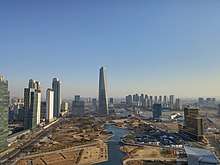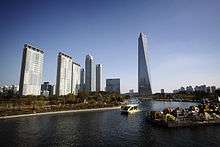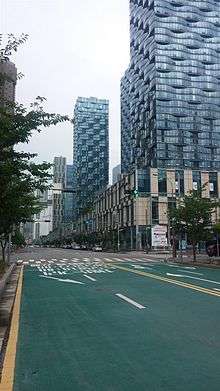Songdo International Business District
Songdo International Business District (Songdo IBD) is a smart city[1] or "ubiquitous city" built from scratch on 600 hectares (1,500 acres) of reclaimed land along Incheon's waterfront,[2] 30 kilometres (19 mi) southwest of Seoul, South Korea and connected to Incheon International Airport by a 12.3-kilometre (7.6 mi) reinforced concrete highway bridge, called Incheon Bridge. Along with Yeongjong and Cheongna, it is part of the Incheon Free Economic Zone.[3]
Songdo 송도/松島 | |
|---|---|
International Business District | |
| Songdo International Business District | |
 Songdo Location of Songdo in South Korea | |
| Coordinates: 37°23′02.08″N 126°38′37.88″E | |
| Country | South Korea |
| Region | Sudogwon |
| Provincial level | Incheon |
| Time zone | UTC+9 (Korea Standard Time) |
The Songdo International Business District will feature the Northeast Asia Trade Tower, G-tower, and the Incheon Tower. Schools, hospitals, apartments, office buildings and cultural amenities are to be built in the district. Homages of architectural hallmarks, including New York City's Central Park and Venice's waterways, will also be incorporated. This 10-year development project is estimated to cost in excess of $40 billion, making it one of the most expensive development projects ever undertaken.[4]
With 106 buildings and 22 million sq ft. of LEED-certified space, the green building certification by the United States Green Building Council, Songdo IBD makes up about 40% of all LEED-certified space in South Korea.[5]
As of 2018, the population of Songdo exceeds 50,000 people.[6]
Ownership and design
Gale International, holds a majority stake of 61%, Posco 30%, and the remaining 9% is owned by Morgan Stanley Real Estate.[7] The plan was designed by the New York office of Kohn Pedersen Fox (KPF).[8] Infrastructure development, labor, and funding are also being provided by the city of Incheon.
Development



Built on 600 hectares (1,500 acres) of land reclaimed from the Yellow Sea off Incheon, about 56 kilometres (35 mi) from the South's capital Seoul, Songdo district is the largest private real estate development in history. By its completion date in 2015, the district was planned to contain 80,000 apartments, 5,000,000 square metres (50,000,000 sq ft) of office space and 900,000 square metres (10,000,000 sq ft) of retail space.[9] The 65-floor Northeast Asia Trade Tower became South Korea's tallest building. Computers have been built into the houses, streets, and offices as part of a wide area network.[10]
The Songdo IBD was part of former President Lee Myung-bak's effort to promote green and low-carbon growth as an avenue for future development after 60 years of reliance on export-oriented manufacturing. The nation launched a $38 billion economic stimulus package in January 2009, with over 80% of the total earmarked for green investment. The Framework Act for Low Carbon Green Growth, passed by Korea's National Assembly in 2010, increased this to $83.6 billion spanning five years. Under this initiative, the Songdo IBD is being developed as a sustainable city with more than 40% of its area reserved for green space, including the park of 40 hectares (100 acres), 26 kilometres (16 mi) of bicycling lanes, numerous charging stations for electric vehicles and a waste collection system that eliminates the need for trash trucks. Also, it is the first district in Korea to have all of its major buildings on par or beyond LEED's requirements.[11]
Three additional foreign university campuses opened in 2014, for a total of four total universities located within an international business district some 60 kilometres (40 mi) from Seoul, including the first overseas university that opened in Korea, the State University of New York, Stony Brook.[12] The schools will be funded by the Ministry of Knowledge Economy, the Incheon Free Economic Zone and the Incheon Metropolitan Government. The development is part of a $35 billion effort by the Korean government to form an international business district that houses competitive universities from around the world. In spring 2014, George Mason University (Fairfax, Virginia) opened its Korean campus in Songdo to support undergraduate academic interests and professional development programming for local corporations. Additionally, University of Utah anticipated opening a satellite campus in March 2014 with several American bachelor's degrees offered in Social Sciences, along with an M.A. in Applied Linguistics[13]
Sustainability
Though the city is not yet complete, Songdo IBD is home to 106 LEED certified buildings that fall under 12 projects, or 22 million sq ft of LEED-certified space. This number includes several ‘firsts’ for LEED in Korea and Asia, including the first LEED-certified hotel in Korea (the Sheraton Incheon), the first certified residential tower in Korea (Central Park 1), and the first certified convention hall in Asia (Convensia).[14] The 50,000 sq ft clubhouse for the Jack Nicklaus Golf Club Korea which hosted the Presidents Cup in 2015 is also certified. Songdo IBD alone represents 40% of all LEED-certified space in South Korea.[5]
In addition, Songdo IBD utilizes a pneumatic waste disposal system.[15] This means no garbage cans on street corners, and no garbage trucks. Instead, garbage is thrown into pipes that will suck the garbage underground, disposing of waste, and recycling what can be recycled.[16]
There are also 25 km of bike paths and charging stations for electric vehicles throughout the city.[15]
"Ubiquitous City" (Smart City)
Songdo IBD was designed and created to be a "ubiquitous city", or a smart city. What is "ubiquitous" is the technology, i.e. computers are built into the buildings and streets. For example, Songdo IBD residents can video-conference with their neighbors, or even attend classes remotely.[17] They can control lighting, heating, air conditioning and more, all with the push of a button on a control panel.[18] Sensors gather information on things like traffic flow and energy use. This kind of information can be converted into alerts that tell citizens when a bus will arrive, or notify the authorities when a crime is taking place.[19] The water pipes are designed to prevent drinkable water from being wasted in showers and toilets.[20]
UN Green Climate Fund
In October 2012 Songdo IBD was selected to become the home to the United Nations Green Climate Fund (GCF). One of the reasons for selection is the environmental-friendly practices that were incorporated into the city's foundation.[21] Being selected for the GCF marked the first time a large global environmental agency would be hosted in Asia.[22]
The GCF is like the World Bank for green growth, as it offers financial aid to developing countries in their quest to combat climate change. South Korea beat out 5 other competitors for this opportunity, as part of former South Korean President Lee Myung-Bak's initiative for green growth in Korea.[23] The other competing countries were Germany, Switzerland, Mexico, Namibia, and Poland. According to Chief Secretary Kim Sang-hyup, the win for selection came at only 10 days before the decision was due, and mainly because the United States decided to lend its support to Korea.[22]
Transportation
Songdo IBD has atypically wide roads and has a higher number of bicycle paths and walkways. The district is served by buses and by Incheon Metro Line 1, with six(will add one more station in 2021) stations, some with elegant interiors and interior sky-lit vistas. Although travel to Incheon International Airport is quick with the 12.3 km Incheon Bridge, transportation via subway to Seoul is less direct and requires multiple transfers but two Red class[24] commuter buses offer direct routes to the capital city.
Reception
In 2003, Birds Korea called for a halt of the reclamation project due to concerns at the loss of important tidal flats. Prior to reclamation, the Songdo tidal flats had supported several threatened waterbird species, and provided a staging ground for migratory waders as they traveled between the Northern and Southern hemispheres.[25]
Popular culture
Songdo International Business District was heavily featured in episodes 68 and 81 of the South Korean variety show Running Man filmed in 2011 and 2012 respectively. It also provided the backdrop for the music video for "Gangnam Style" and "Right Now", by Korean pop star Psy.
Projects
- George Mason University Korea Campus
- Ghent University Global Campus
- University of Utah Asia Campus
- Yonsei University, International Campus
- Global Information Complex,[26] Inha University
- Chadwick International
- First World
- Jack Nicklaus Golf Club Korea
- Northeast Asia Trade Tower
- Sheraton Incheon Hotel
- Songdo Canal Walk
- Songdo Convensia
- Songdo Central Park
- University of Incheon
Gallery
Songdo International City seen from Gyeonggi Province
References
- Lichá, Alexandra (2018). “Green” and “Smart” Cities Diffusion: The Case of Songdo, Korea. In David G. Hebert (Ed.), International Perspectives on Translation, Education and Innovation in Japanese and Korean Societies. Cham: Springer, p.223-240.
- Henry, Christopher. "Songdo International Business District / KPF". Arch Daily. Retrieved 2012-05-13.
- Chohan, Usman W. "The Ubiquitous City – Songdo (송도)". McGill University. Retrieved 2014-05-14.
- Gassmann, Oliver; Böhm, Jonas; Palmié, Maximilian (2019). Smart Cities: Introducing Digital Innovation to Cities. Emerald Group Publishing. ISBN 978-1-78769-615-0.
- "Championship golf course secures Songdo IBD's sustainable status - U.S. Green Building Council". www.usgbc.org. Retrieved 5 June 2017.
- Poon, Linda (22 June 2018). "Songdo, South Korea's Smartest City". City Lab.
- Chow, Cecilia. "GALE INTERNATIONAL BUILDS CITY FROM SCRATCH".
- "New Songdo City". KPF.
- Online, Asia Time. "Asia Times Online :: Korea News and Korean Business and Economy, Pyongyang News". www.atimes.com. Retrieved 5 June 2017.
- "New Songdo City: Atlantis of the Far East - Asia, World - The Independent". The Independent. London. 2009-06-22.
- Lobo, Rita (December 9, 2013). "South Korea's hi-tech city: Songdo". Business Destinations.
- Park, Eun-jee. "SUNY Stony Brook brings math and science expertise to Songdo campus". Korea jongang Daily. Retrieved 6 April 2013.
- 상희, 배. "송도 글로벌캠퍼스에 내년 외국대 분교 3곳 문 열어". yanhapnews. Retrieved 6 April 2013.
- "Korea's Songdo International Business District - U.S. Green Building Council". www.usgbc.org. Retrieved 5 June 2017.
- "South Korea Conceptualizes the Ultimate Smart City - NewCities". 28 December 2014. Retrieved 5 June 2017.
- Bethea, Ross Arbes and Charles. "Songdo, South Korea: City of the Future?". Retrieved 5 June 2017.
- O'connell, Pamela Licalzi (5 October 2005). "Korea's High-Tech Utopia, Where Everything Is Observed". Retrieved 5 June 2017 – via NYTimes.com.
- Anmar Frangoul (31 March 2016). "Is this the city of the future?". CNBC. Retrieved 5 June 2017.
- Williamson, Lucy (2 September 2013). "Tomorrow's cities: Just how smart is Songdo?". Retrieved 5 June 2017 – via www.bbc.com.
- "Could Songdo be the world's smartest city?". Retrieved 5 June 2017.
- "Built-from-scratch Songdo starts coming to life". Korea JoongAng Daily. Retrieved 5 June 2017.
- http://www.korea.net/NewsFocus/Policies/view?articleId=103244
- "Songdo to host UN climate fund". 21 October 2012. Retrieved 5 June 2017.
- http://www.ifez.go.kr/global/biz/contents/CTS_0000000000000190/getContents.do
- Last call for Songdo Birds Korea
- "Inha Global Knowledge Complex @ Songdo International Business District". Inha University. Archived from the original on 16 October 2014. Retrieved 6 June 2017.
External links
| Wikimedia Commons has media related to Songdo International Business District. |
- New Island Hopes to Be Hong Kong Of Korea, New York Times September 24, 2004.
- Inha Global Knowledge Complex @ Songdo International Business District